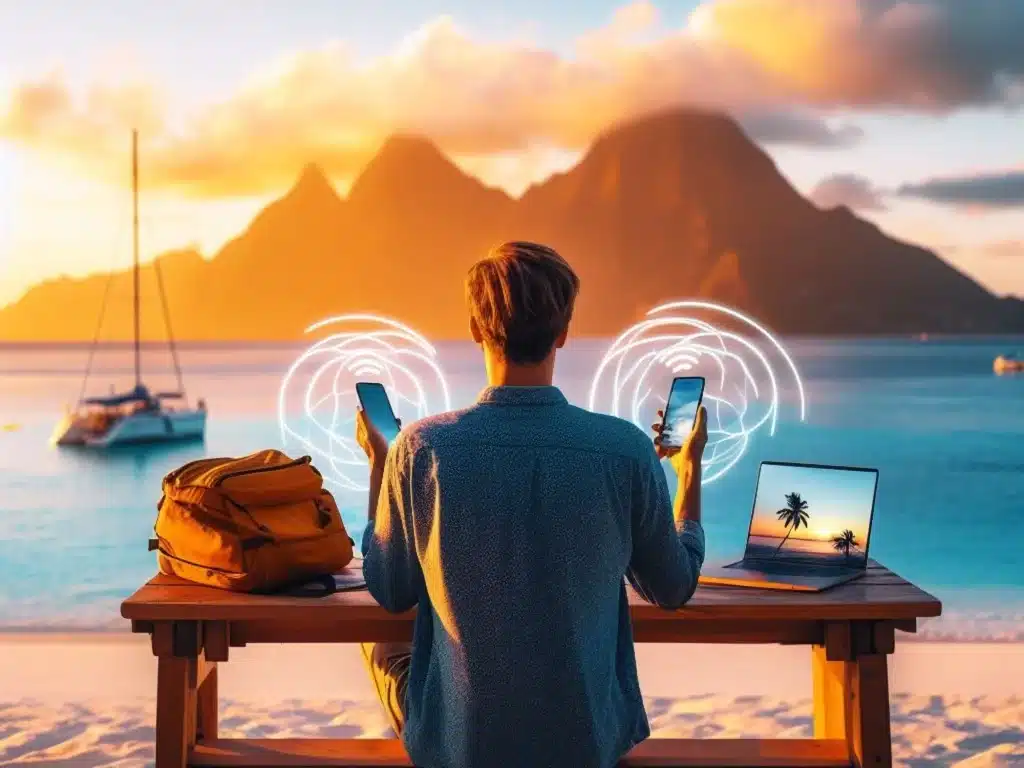In 2025, travel planning for remote destinations is undergoing a transformative shift. Advancements in technology, changes in traveler preferences, and a growing emphasis on sustainability are reshaping how we explore lesser-known locales. From AI-driven planning tools to eco-conscious retreats, the travel landscape is more dynamic than ever. This guide examines emerging trends and provides practical strategies to help you plan a fulfilling journey to remote destinations.

Understanding the Shift in Travel Preferences
The Rise of “Coolcations”
Climate change and rising global temperatures have led travelers to seek cooler, more comfortable destinations. Countries with milder climates, such as Scotland, have experienced a surge in interest from European tourists aiming to escape heatwaves. Cities like Edinburgh and Glasgow have seen a substantial increase in flight searches, particularly from southern European nations, during peak summer months. This trend, often referred to as “coolcations,” reflects a growing preference for unique, climate-friendly experiences away from the overcrowded tourist hubs.
Examples of popular coolcation spots in 2025:
- Scotland: Known for its dramatic landscapes, castles, and historic towns, Scotland is ideal for travelers looking to explore natural beauty in a temperate climate.
- Iceland: With geothermal pools, glaciers, and volcanic landscapes, Iceland offers a remote and adventurous escape.
- New Zealand: Its diverse scenery, from fjords to mountains, makes it an appealing option for nature-focused travelers seeking cooler weather.
Embracing Lesser-Known Destinations
The trend of exploring hidden gems continues to gain momentum. Travelers are increasingly moving away from traditional hotspots in favor of destinations that provide cultural authenticity and fewer crowds. In Asia, locations such as Zhangjiajie and Yangshuo in China, and Kanazawa and Nagano in Japan, have seen a significant rise in interest. These areas offer stunning natural scenery, unique cultural experiences, and opportunities for sustainable tourism practices.
Choosing lesser-known destinations also helps avoid overtourism and promotes economic support for smaller communities. Travelers seeking authentic experiences can participate in local festivals, craft workshops, or guided nature excursions that are often overlooked by mainstream tourists.
Leveraging Technology for Smarter Planning
AI-Powered Travel Assistance
Artificial Intelligence (AI) is revolutionizing how people plan trips. Modern AI-powered platforms allow travelers to describe their ideal getaway—such as climate preferences, budget, or type of activities—and receive personalized suggestions for destinations, accommodations, and itineraries. This technology enables travelers to discover options they might not have previously considered, making planning both efficient and exciting.
Travel agencies are also integrating AI tools to enhance their services. From generating customized itineraries to managing customer communications and tracking deals, AI helps streamline operations, allowing travelers to access more tailored options without spending excessive time on research.
Practical AI-based tools to consider:
- Trip recommendation engines: AI suggests destinations and experiences based on personal interests.
- Flight and hotel monitoring tools: These track price fluctuations and notify users of the best deals.
- Smart itinerary planners: Combine activities, accommodations, and transport into a cohesive travel plan.
Sustainable Travel: A Growing Priority
Conscious Travel Choices
Sustainability has become a central consideration for modern travelers. Many are now opting for destinations and services that prioritize eco-friendly practices, support local communities, and minimize environmental impact. Choosing remote destinations often aligns with these values, as such areas are less affected by overtourism.
Ways to make travel sustainable:
- Select eco-certified accommodations that use renewable energy, recycle waste, and conserve water.
- Support local businesses, such as family-run restaurants, artisan shops, and guided tours.
- Participate in responsible tourism experiences, including wildlife conservation programs and cultural immersion activities.
Digital Detox Retreats
Another emerging trend is digital detox retreats, which provide travelers with opportunities to disconnect from technology and immerse themselves fully in local culture and natural environments. These retreats often include wellness-focused activities such as yoga, meditation, hiking, and farm-to-table cooking experiences.
Popular regions for digital detox retreats in 2025:
- Ireland: Remote cottages and eco-lodges offer quiet escapes in lush landscapes.
- Morocco: Desert retreats and mountain lodges provide serene environments for reflection.
- Norway: Fjord-side cabins with minimal connectivity encourage relaxation and immersion in nature.
Practical Tips for Planning Your Remote Getaway
1. Research and Select Your Destination
Choosing the right destination requires careful consideration of multiple factors:
- Climate Considerations: Ensure the destination has favorable weather during your intended travel dates.
- Cultural and Natural Attractions: Opt for places that provide unique cultural experiences and natural beauty.
- Sustainability Practices: Prioritize destinations and accommodations that implement eco-friendly and community-supporting practices.
2. Utilize Technology for Planning
Modern technology makes travel planning more efficient and customized:
- AI Tools: Use AI-powered platforms to identify destinations and itineraries aligned with your preferences.
- Travel Apps: Apps can assist with bookings, transportation, and discovering local experiences.
- Navigation Tools: Offline maps and GPS applications help you navigate remote areas without connectivity concerns.
3. Consider Remote Work Opportunities
With remote work becoming more prevalent, travelers are increasingly combining leisure with professional responsibilities:
- Work-Friendly Destinations: Choose locations with reliable internet connectivity and conducive workspaces.
- Accommodation Options: Look for lodgings that provide co-working spaces, ergonomic setups, and quiet environments.
- Time-Zone Management: Plan your schedule to balance work commitments and sightseeing effectively.
4. Plan for Sustainability
Sustainable planning ensures your travel has a positive impact:
- Eco-Friendly Accommodations: Opt for lodgings that reduce energy use, manage waste, and engage with local communities.
- Local Experiences: Participate in cultural events, cooking classes, or guided tours led by locals.
- Conscious Transportation: Favor public transport, cycling, or walking over private vehicles whenever possible.
Sample Remote Destination Itineraries
To make the concept more practical, here are two sample itineraries for remote destinations:
Scotland – Highlands Exploration (7 Days)
- Day 1-2: Edinburgh – Explore historic sites, castles, and local cuisine.
- Day 3-4: Isle of Skye – Hike scenic trails, visit waterfalls, and stay in eco-lodges.
- Day 5-6: Cairngorms National Park – Wildlife spotting, guided nature tours, and digital detox experiences.
- Day 7: Return to Edinburgh for local shopping and cultural activities.
Japan – Hidden Gems in Kanazawa & Nagano (6 Days)
- Day 1: Kanazawa – Visit traditional gardens, samurai districts, and local markets.
- Day 2-3: Explore Kanazawa’s art museums and cultural workshops.
- Day 4: Travel to Nagano – Hike scenic trails in the Japanese Alps.
- Day 5: Participate in local festivals or cultural events.
- Day 6: Conclude with a stay in a sustainable ryokan, enjoying traditional meals.
Anticipated Trends in Remote Destination Travel
Looking ahead, several key trends are shaping the future of travel planning for remote destinations:
- Expanded Role of AI in Personalized Travel: Travelers will increasingly rely on AI for tailored recommendations, itinerary optimization, and deal alerts.
- Digital Nomad Communities: Remote work is fueling the creation of dedicated hubs in remote regions, combining coworking spaces with local experiences.
- Experiential Travel: Travelers are prioritizing immersive experiences over sightseeing, seeking cultural exchange, and hands-on activities.
- Sustainable Tourism: Demand for eco-conscious travel will continue to rise, influencing accommodations, transportation, and activity choices.
Conclusion
Travel planning for remote destinations in 2025 is defined by innovation, sustainability, and the pursuit of authentic experiences. By leveraging AI tools, exploring lesser-known locations, and prioritizing eco-friendly practices, travelers can craft journeys that are memorable, enriching, and environmentally responsible. From coolcations to digital detox retreats, the future of travel emphasizes meaningful connections with people, culture, and nature.
By researching destinations carefully, using technology wisely, and adopting sustainable practices, your next trip to a remote destination can be both practical and inspiring.
References:
- Switchfly. (2025). Emerging travel trends for 2025. Available at: https://www.switchfly.com (Accessed: 18 August 2025).
- Points Guy. (2025). Sustainable travel trends shaping the future of tourism. Available at: https://www.thepointsguy.com (Accessed: 18 August 2025).
- News.com.au. (2025). Aussies venture beyond the hotspots in 2025 to hidden gems in China and Japan. Available at: https://www.news.com.au (Accessed: 18 August 2025).









